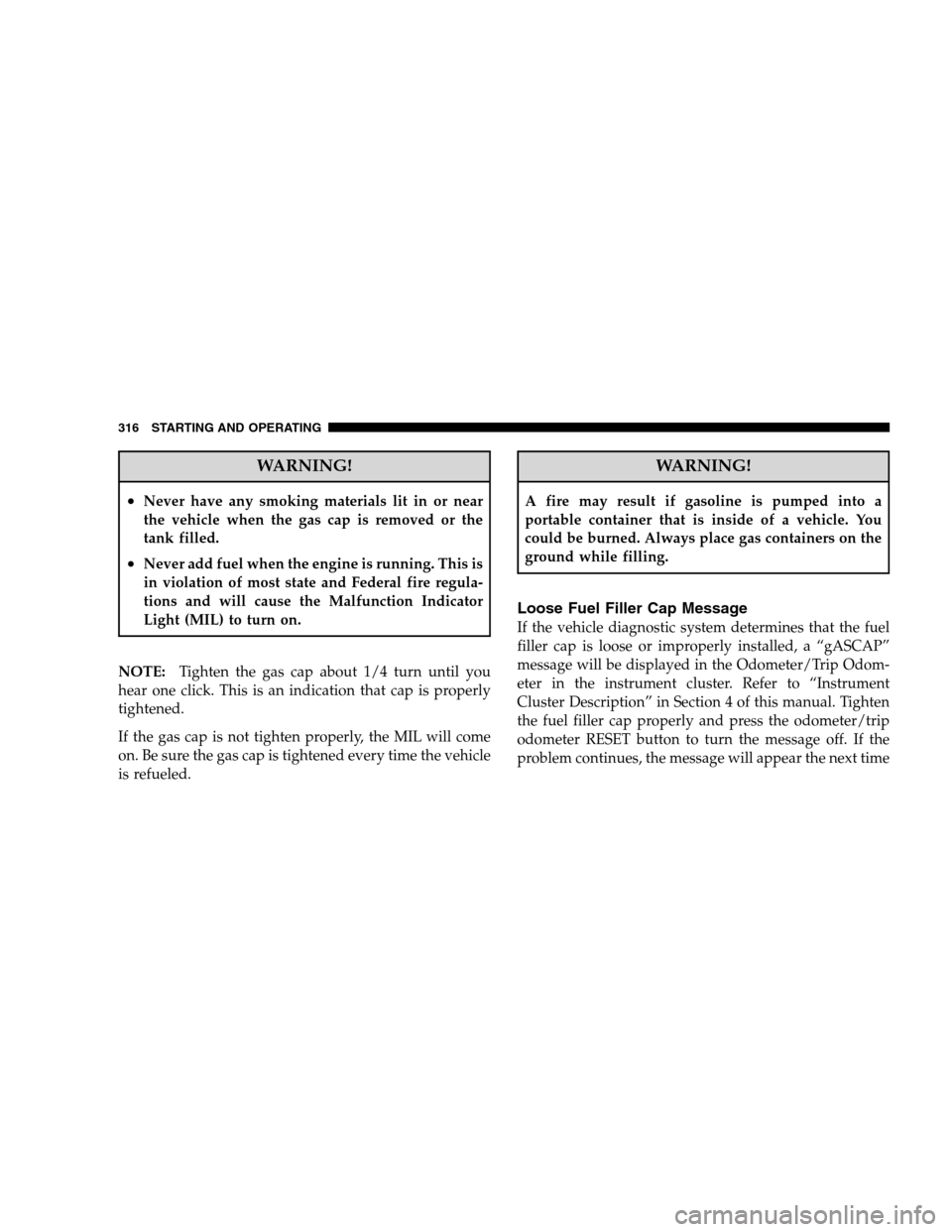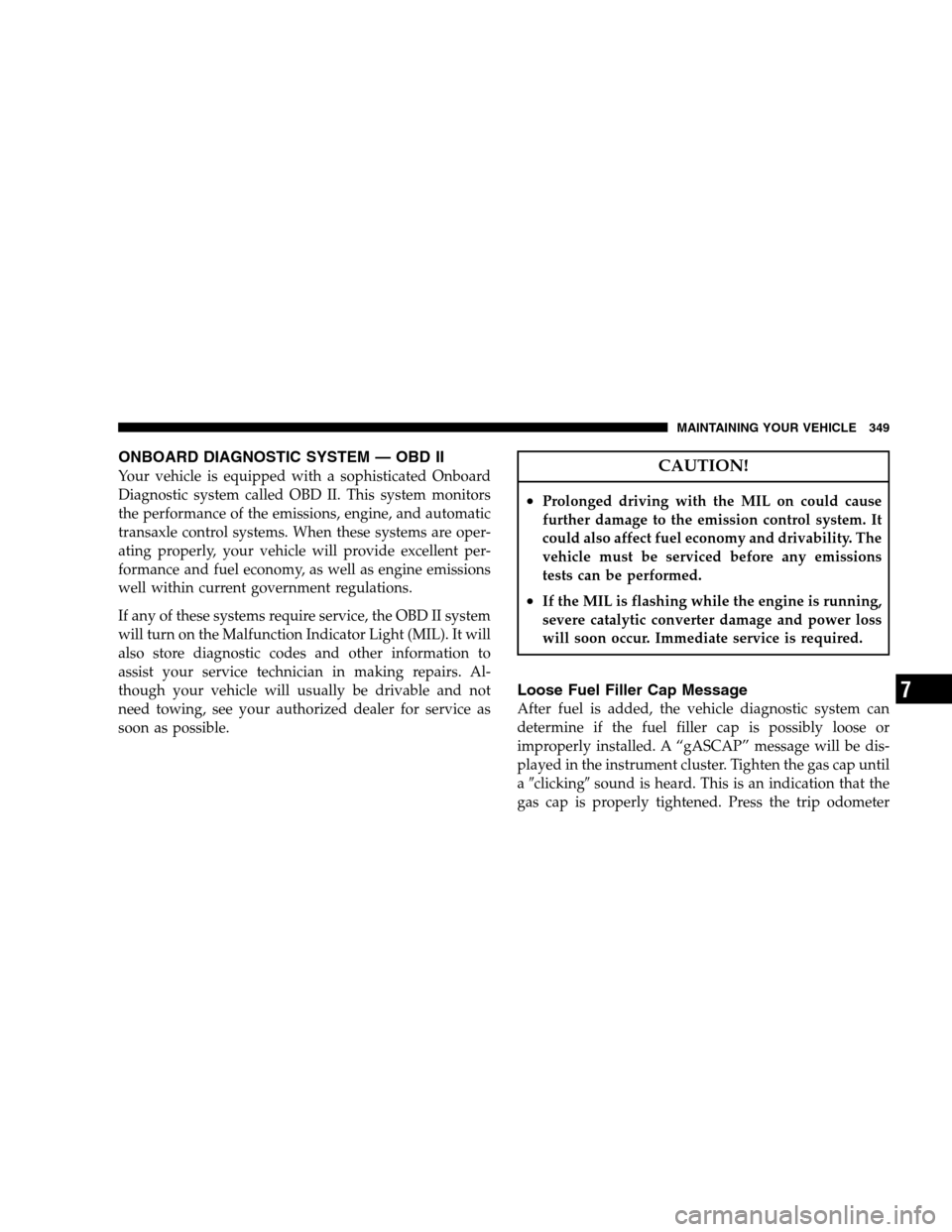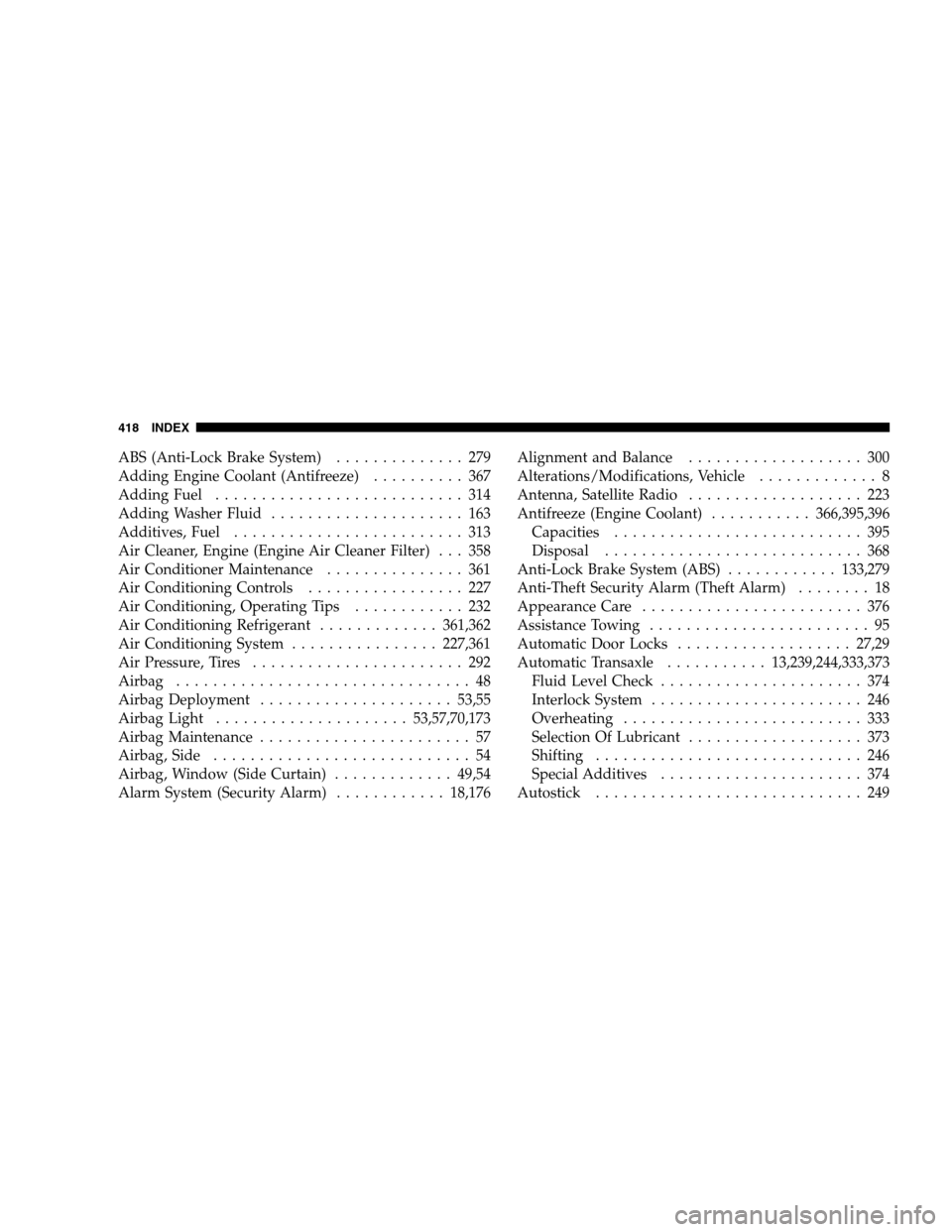Page 318 of 438

WARNING!
•Never have any smoking materials lit in or near
the vehicle when the gas cap is removed or the
tank filled.
•Never add fuel when the engine is running. This is
in violation of most state and Federal fire regula-
tions and will cause the Malfunction Indicator
Light (MIL) to turn on.
NOTE:Tighten the gas cap about 1/4 turn until you
hear one click. This is an indication that cap is properly
tightened.
If the gas cap is not tighten properly, the MIL will come
on. Be sure the gas cap is tightened every time the vehicle
is refueled.
WARNING!
A fire may result if gasoline is pumped into a
portable container that is inside of a vehicle. You
could be burned. Always place gas containers on the
ground while filling.
Loose Fuel Filler Cap Message
If the vehicle diagnostic system determines that the fuel
filler cap is loose or improperly installed, a “gASCAP”
message will be displayed in the Odometer/Trip Odom-
eter in the instrument cluster. Refer to “Instrument
Cluster Description” in Section 4 of this manual. Tighten
the fuel filler cap properly and press the odometer/trip
odometer RESET button to turn the message off. If the
problem continues, the message will appear the next time
316 STARTING AND OPERATING
Page 319 of 438

the vehicle is started. Refer to “Onboard Diagnostic
System — OBD II” in Section 7 of this manual for more
information.
CAUTION!
Damage to the fuel system or emission control sys-
tem could result from using an improper fuel tank
filler cap (gas cap). A poorly fitting cap could let
impurities into the fuel system.
VEHICLE LOADING
Vehicle Loading Capacities:
Front Seat Occupants....................... 2
Rear Seat Occupants....................... 3
Luggage....................... 175lbs(80kg)
Vehicle Rated Capacity............ 925lbs(420 kg)
Gross Vehicle Weight Rating (GVWR)
The GVWR is the total allowable weight of your vehicle.
This includes the weight of your vehicle, the driver,
passengers, cargo and trailer tongue weight. The total
load must be limited so that you do not exceed the
GVWR.
TRAILER TOWING
In this section you will find safety tips and information
on limits to the type of towing you can reasonably do
with your vehicle. Before towing a trailer, carefully
review this information to tow your load as efficiently
and safely as possible.
To maintain warranty coverage, follow the requirements
and recommendations in this manual concerning ve-
hicles used for trailer towing.
STARTING AND OPERATING 317
5
Page 347 of 438
MAINTAINING YOUR VEHICLE
CONTENTS
�Engine Compartment — Gasoline...........348
�Onboard Diagnostic System — OBD II........349
▫Loose Fuel Filler Cap Message............349
�Emissions Inspection And Maintenance
Programs............................350
�Replacement Parts......................351
�Authorized Dealer Service................352
�Maintenance Procedures..................352
▫Engine Oil..........................352▫Drive Belt — Check Condition............356
▫Spark Plugs.........................356
▫Catalytic Converter....................356
▫Crankcase Emission Control System........358
▫Fuel Filter..........................358
▫Air Cleaner Element (Filter)..............358
▫Maintenance-Free Battery................359
▫Air Conditioner Maintenance.............361
▫Power Steering — Fluid Check............362
7
Page 351 of 438

ONBOARD DIAGNOSTIC SYSTEM — OBD II
Your vehicle is equipped with a sophisticated Onboard
Diagnostic system called OBD II. This system monitors
the performance of the emissions, engine, and automatic
transaxle control systems. When these systems are oper-
ating properly, your vehicle will provide excellent per-
formance and fuel economy, as well as engine emissions
well within current government regulations.
If any of these systems require service, the OBD II system
will turn on the Malfunction Indicator Light (MIL). It will
also store diagnostic codes and other information to
assist your service technician in making repairs. Al-
though your vehicle will usually be drivable and not
need towing, see your authorized dealer for service as
soon as possible.CAUTION!
•Prolonged driving with the MIL on could cause
further damage to the emission control system. It
could also affect fuel economy and drivability. The
vehicle must be serviced before any emissions
tests can be performed.
•If the MIL is flashing while the engine is running,
severe catalytic converter damage and power loss
will soon occur. Immediate service is required.
Loose Fuel Filler Cap Message
After fuel is added, the vehicle diagnostic system can
determine if the fuel filler cap is possibly loose or
improperly installed. A “gASCAP” message will be dis-
played in the instrument cluster. Tighten the gas cap until
a�clicking�sound is heard. This is an indication that the
gas cap is properly tightened. Press the trip odometer
MAINTAINING YOUR VEHICLE 349
7
Page 356 of 438
Change Engine Oil
Refer to the “Maintenance Schedule” in Section 8 for
recommended engine oil change intervals.
Engine Oil Selection (Gasoline Engines)
For best performance and maximum protection for all
engines under all types of operating conditions, the
manufacturer recommends engine oils that are API Cer-
tified and meet the requirements of DaimlerChrysler
Material Standard MS-6395.
American Petroleum Institute (API) Engine Oil
Identification Symbol
This symbol means that the oil has
been certified by the American
Petroleum Institute (API). The
manufacturer only recommends
API Certified engine oils.
Engine Oil Viscosity (SAE Grade)
SAE 5W-20 engine oil is recommended for all operating
temperatures. This engine oil improves low temperature
starting and vehicle fuel economy. Your engine oil filler
cap also states the recommended engine oil viscosity
grade for your engine.
354 MAINTAINING YOUR VEHICLE
Page 397 of 438
FLUIDS AND CAPACITIES
U.S. Metric
Fuel (Approximate)13.5 Gal 51.0 L
Engine Oil-With Filter
All Gasoline Engines (use API Certified SAE 5W-20 Engine Oil) 4.5 qts 4.26 L
Cooling System *
Mopar�Antifreeze/Coolant 5 Year/100,000 Miles Formula), or
equivalent.7.2 qts 6.8 L
* Includes heater and coolant recovery bottle filled to MAX level.
MAINTAINING YOUR VEHICLE 395
7
Page 398 of 438
FLUIDS, LUBRICANTS, AND GENUINE PARTS
Engine
Component Fluids, Lubricants And Genuine Parts
Engine Coolant Mopar�Antifreeze/Coolant 5 Year/100,000 Mile Formula HOAT (Hybrid Or-
ganic Additive Technology) or equivalent.
Engine Oil Use API Certified SAE 5W-20 Engine Oil. Refer to your engine oil filler cap
for correct SAE grade meeting DaimlerChrysler Material Standard MS-6395.
Engine Oil Filter Mopar�04884900AB or equivalent.
Spark Plugs ZFR5F-11 (Gap 0.043”)
Fuel Selection 87 Octane (R + M)/2
396 MAINTAINING YOUR VEHICLE
Page 420 of 438

ABS (Anti-Lock Brake System).............. 279
Adding Engine Coolant (Antifreeze).......... 367
Adding Fuel........................... 314
Adding Washer Fluid..................... 163
Additives, Fuel......................... 313
Air Cleaner, Engine (Engine Air Cleaner Filter) . . . 358
Air Conditioner Maintenance............... 361
Air Conditioning Controls................. 227
Air Conditioning, Operating Tips............ 232
Air Conditioning Refrigerant.............361,362
Air Conditioning System................227,361
Air Pressure, Tires....................... 292
Airbag................................ 48
Airbag Deployment..................... 53,55
Airbag Light..................... 53,57,70,173
Airbag Maintenance....................... 57
Airbag, Side............................ 54
Airbag, Window (Side Curtain)............. 49,54
Alarm System (Security Alarm)............ 18,176Alignment and Balance................... 300
Alterations/Modifications, Vehicle............. 8
Antenna, Satellite Radio................... 223
Antifreeze (Engine Coolant)...........366,395,396
Capacities........................... 395
Disposal............................ 368
Anti-Lock Brake System (ABS)............133,279
Anti-Theft Security Alarm (Theft Alarm)........ 18
Appearance Care........................ 376
Assistance Towing........................ 95
Automatic Door Locks................... 27,29
Automatic Transaxle........... 13,239,244,333,373
Fluid Level Check...................... 374
Interlock System....................... 246
Overheating.......................... 333
Selection Of Lubricant................... 373
Shifting ............................. 246
Special Additives...................... 374
Autostick ............................. 249
418 INDEX